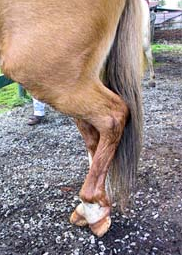By Paige Cerulli, Certified Equine Massage Therapist
Your horse’s posture can reveal important information about what is going on in his body. Taking the time to assess your horse’s posture can help you to identify injuries, weaknesses, and other issues before they become too significant. Let’s take a look at some of the more common posture issues you may see, and what they may indicate.
Arching the Neck While Being Saddled
Watch your horse’s reaction while he’s being saddled. Look to see if you observe any of the following in your horse:
- Arched neck
- Hollowed back
- Moving away from the saddle
- Tensing the muscles in the upper areas of his neck or back
- Twitching muscles in the saddle area
All of these symptoms may indicate that you have a saddle fit issue, though they can also indicate that your horse may be “cold backed” or in need of a chiropractic alignment. It’s important to have your vet and/or a chiropractor out to assess your horse, and to carefully evaluate the fit of your saddle.
Consistently Resting One Hind Foot

If you notice that your horse frequently rests one particular hind foot while he’s standing, this may indicate weakness, pain, or that your horse’s hips have gone out of alignment. Issues can vary from something as small as a developing hoof abscess to something much more significant, such as an injury sustained during a fall.
It’s best to have your vet out for a workup. A chiropractor may be needed to help realign your horse, and if an injury is at the root of the cause, additional treatment may be necessary.
Tilting the Head When Eating
Have you noticed that your horse has started to tilt his head to the side while eating? This may indicate that your horse needs dental work, though it can also indicate that your horse’s spine is out of alignment. Head tilting can also result when a horse is dealing with extremely tight muscling in their neck, generally as the result of an injury or fall.
Your first step should be to have your vet out to evaluate your horse’s teeth and body. A chiropractor may help if your horse is out of alignment, and massage can help to relieve tense muscles.
Uneven Muscling

Uneven Muscles
With your horse standing squarely, look at him from directly in front and then directly behind him. Look for areas where his muscling has developed unevenly – you’ll notice that the muscle on one side of his body is more developed than it is on the other side.
Uneven muscling can indicate that your horse is suffering from a particular weakness or injury. This condition may show that one leg is compensating for another which is sore or somehow restricted. It’s important to take action when you notice uneven muscling developing – this development generally precedes lameness in your horse.
Have your vet out to assess your horse’s movement and help you identify the issue at hand. Issues can range from a tendon injury to a skeletal misalignment.
No matter which postural issue you may notice in your horse, it’s important to work closely with your vet to get to the root of the problem. Your vet can advise you whether chiropractic work may be appropriate for your horse. Anytime that your horse has chiropractic work done, massaging him can help to loosen up the muscles which have grown accustomed to being in this new, improper position. Massaging your horse helps to retrain the muscles, allowing the changes the chiropractor makes to “stick” longer before the muscles pull your horse’s skeleton back into this improper position.
The Posture Prep Cross Fiber Groomer, paired with some patience and observing eyes, can help you to identify and relieve some of your horse’s physical issues.

